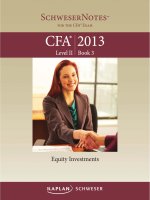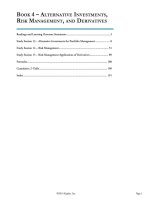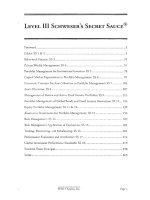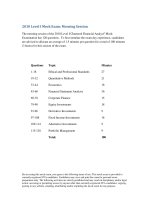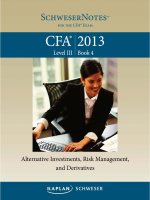CFA level 3 mock exam 5 level 3 mock 2017
Bạn đang xem bản rút gọn của tài liệu. Xem và tải ngay bản đầy đủ của tài liệu tại đây (606.17 KB, 191 trang )
FinQuiz.com
CFA Level III Mock Exam 5
June, 2017
Revision 1
Copyright © 2010-2017. FinQuiz.com. All rights reserved. Copying, reproduction
or redistribution of this material is strictly prohibited.
CFA Level III Mock Exam 5 – Questions (AM)
FinQuiz.com – 5th Mock Exam 2017 (AM Session)
The morning session of the 2017 Level III CFA Examination has 12 questions. For
grading purposes, the maximum point value for each question is equal to the number of
minutes allocated to that question.
Questions Topic
Minutes
1
Portfolio Management – Individual
26
2
Portfolio Management – Individual
10
3
Portfolio Management – Individual
3
4
Portfolio Management – Institutional
35
5
Portfolio Management – Institutional
16
6
Portfolio Management – Asset Allocation
10
7
Portfolio Management – Asset Allocation
18
8
Portfolio Management – Economics
19
9
Portfolio Management – Equity Investments
17
10
Portfolio Management – Monitoring and Rebalancing
6
11
Portfolio Management – Risk Management
15
12
Portfolio Management – Derivatives
5
Total:
FinQuiz.com © 2017 - All rights reserved.
180
2
CFA Level III Mock Exam 5 – Questions (AM)
QUESTION 1 HAS SIX PARTS (A, B, C, D and E) FOR A TOTAL OF 26
MINUTES
Kyle Lucas is the owner of a privately traded manufacturing concern which is currently
worth $15 million and was established twenty-five years ago. Lucas is 65 years of age
and intends to sell the business three years from today.
Lucas has approached portfolio manager Gus Weaver to manage his investment portfolio
which is currently worth $8.5 million and is equally allocated to long-term corporate
bonds, domestic and international equities, and alternative asset classes. In response to a
question regarding his investment experience, Lucas states, “I have faced significant
financial crises in the past and now always look to avoid making investment choices
which hold the potential for disastrous consequences.”
Lucas earns annual business income which is fixed at a pre-tax amount of $100,000. His
living expenses are $98,000 in the current year and are expected to increase at the annual
rate of inflation of 5%. Upon retirement, he will no longer earn business income and his
annual living expenses will become constant at $150,000.
If Lucas sells his business at its current market price, three years from today, he will be
able to meet his retirement living expenses and purchase a boat currently sold at a price
of $1.0 million. He has instructed Weaver to exclude the boat purchase from the
investment decision. Lucas intends to finance his grandson’s college education as well as
purchase residential property for him. Total estimated costs will amount to $30 million
and will be required fifteen years from today.
Lucas is subject to an ordinary income and capital gains tax rate of 25% and 30%
respectively. He always maintains an emergency reserve equal to 3 years of his annual
business income in addition to his portfolio holdings.
A. Formulate each of the following constraints for Lucas’ investment policy
statement (IPS):
I.
II.
Time Horizon
Unique Circumstances
(4 minutes)
FinQuiz.com © 2017 - All rights reserved.
3
CFA Level III Mock Exam 5 – Questions (AM)
B. Determine whether an increase in inflation rate, reduction in the sales price of the
business, and an increase in the price of the boat will increase, decrease or have
no impact on risk tolerance. Justify your choice with one reason.
Answer Question 1-B in the template provided on page 6.
(6 minutes)
C. State Lucas’s return objective for his IPS.
(3 minutes)
D. Calculate Lucas’ annual after-tax nominal rate of return for the IPS if his
business is sold at its current market price three years from today. Show your
calculations.
(6 minutes)
Walker strongly feels that incorporating behavioral considerations in an IPS is essential
to fulfilling the client’s long-term goals. To achieve this purpose, he holds a meeting with
Lucas to determine his behavioral investor type (BIT) and associated biases by holding a
meeting with the client.
E. Discuss two benefits of including behavioral finance into the IPS.
(4 minutes)
Lucas is an avid follower of the stock market and makes investment decisions on behalf
of friends and family members. His most recent investment decision involved a $100,000
purchase of French Inc’s stock. The decision was influenced by recent media attention on
the corporation following a ‘brave’ policy shift towards unconventional production
processes promising shorter lead times and a greater focus on organic raw materials as
input. He further justifies his decisions by stating, “Over the course of industry history,
companies who were experimental in setting their policy have been popular amongst
investors.”
FinQuiz.com © 2017 - All rights reserved.
4
CFA Level III Mock Exam 5 – Questions (AM)
F. Identify the bias demonstrated by Lucas and justify your selection with one
reason.
(3 minutes)
Answer Question 1-F in the template provided on page 7.
FinQuiz.com © 2017 - All rights reserved.
5
CFA Level III Mock Exam 5 – Questions (AM)
Template for Question 1-B
Impact on Risk
Tolerance (Circle
the Correct
Answer)
Factor
Justify Your Choice With
One Reason
Increase
Increase in inflation rate
Decrease
No impact
Increase
Reduction in sales price of business
Decrease
No impact
Increase
Increase in the price of the boat
Decrease
No impact
FinQuiz.com © 2017 - All rights reserved.
6
CFA Level III Mock Exam 5 – Questions (AM)
Template for Question 1-F
Identify the Bias (Circle the
Correct Choice)
Justify Your Choice With One
Reason
Regret Aversion
Overconfidence
Availability Bias
FinQuiz.com © 2017 - All rights reserved.
7
CFA Level III Mock Exam 5 – Questions (AM)
QUESTION 2 HAS TWO PARTS (A, B) FOR A TOTAL OF 10 MINUTES
Carl Segal is an asset advisor at Vector Asset Management. Segal is working closely with
a private client, Timothy Allen; aged 45 to ascertain the behavioral investor type (BIT)
exhibited by Allen. Allen has considerable investment experience and often recommends
potential investments for further evaluation to his adviser. During a discussion between
Segal and Allen, the client shares his investment approach:
“I have devoted a significant amount of time to studying security markets and asset
classes. Based on the insight which I have gained over these years, I can comfortably
trust my instincts when making investment decisions for myself as well as acquaintances,
who have entrusted me with the management of their financial wealth. I trust nothing but
my own research and prefer not to let my judgment get influenced by the advice of those
who possess little knowledge about wealth planning.”
A. Classify Carl’s BIT, determine the risk tolerance, and identify one emotional bias
typically associated with the identified behavioral category.
(3 minutes)
Answer Question 2-A in the Template provided on page 10.
B. Carl participates in the defined contribution (DC) offered by his employer. Segal
determines that Carl is fifteen years away from retirement. Segal would like to
compare the client’s current allocation to plan assets with the average allocation
held over the past five years. Segal also determines that:
•
•
•
•
Carl’s annual income sufficiently covers his living expenses.
he is unmarried but finances his brother’s medical care. His brother is
mentally challenged. His salary is not sufficient to cover these expenses.
he has inherited $1.5 million from his deceased father’s estate in the
beginning of the current year. He intends to employ these funds for
investment purposes.
he has assigned a risk score of 3.1 to the average company stock, in
comparison with 3.6 to domestic stock funds and 4.1 to global stock funds.
FinQuiz.com © 2017 - All rights reserved.
8
CFA Level III Mock Exam 5 – Questions (AM)
Exhibit:
Carl’s Allocations to the DC Plan Assets
Average
Historical
Allocation
(2009-2013)
Stocks – Corporate stock
36%
Stocks – Domestic Non-corporate stocks
6
Stocks – Global stocks
3
Fixed Income
45
Short-term income
10
Total
100%
I.
Current
Allocation
(2014)
34%
7
4
48
9
100%
Using the data collected by Segal, explain one bias exhibited by Carl in his
portfolio selection decisions with respect to the DC plan. Support your response
with two reasons.
(4 minutes)
II.
Based on Segal’s findings, he intends to employ an autopilot strategy to align
Carl’s allocations with his circumstances. Explain how such a strategy would
affect the current allocation.
(3 minutes)
FinQuiz.com © 2017 - All rights reserved.
9
CFA Level III Mock Exam 5 – Questions (AM)
Template for Question 2-A
Classify Carl’s BIT
(Circle the Correct Choice)
Determine Risk Tolerance
Associated With the
Behavioral Category
(Circle the correct choice)
Passive Preserver (PP)
Low
Active Accumulator (AA)
Low to Medium
Friendly Follower (FF)
Medium to High
Independent Individualist (II)
High
FinQuiz.com © 2017 - All rights reserved.
Identify One Emotional
Bias Typically Associated
With the Behavioral
Category
10
CFA Level III Mock Exam 5 – Questions (AM)
QUESTION 3 HAS ONE PART FOR A TOTAL OF 3 MINUTES
Mr. and Mrs. Fairview, aged 65 and 60 respectively, are the owners of a hotel chain
which has branches located across the US and has been in establishment for the past
thirty years. Their business is currently worth $60 million and has appreciated by 10% in
the current year leading to an increase in the wealth of its owners. The hotel chain is a
privately traded concern.
The Fairviews are seeking to transfer the business to their daughter, Samantha, but would
like to retain ownership rights. They have approached Kim Young, a tax advisor, for a
solution. Under current tax laws a donor’s annual gift exclusions are limited to $13,000
per donee. Gifts exceeding this allowance are taxed at a rate of 25%. Young discovers
that the couple has consumed this allowance and now sets out to devise a wealth transfer
strategy which will minimize transfer taxes and retain ownership rights.
After considerable evaluation, Young has identified three potential wealth transfer
strategies. She would now like to determine the most appropriate strategy.
Recommend the most suitable wealth transfer strategy. For the choices not selected
provide one reason for their unsuitability.
Answer Question 3 in the template provided on page 12.
(3 minutes)
FinQuiz.com © 2017 - All rights reserved.
11
CFA Level III Mock Exam 5 – Questions (AM)
Template for Question 3
Recommend the most Suitable Wealth
Transfer Strategy
Provide One Reason for Why the
Choices Not Selected are Unsuitable
Corporate Estate Tax Freeze
Family Limited Partnership
Direct Gifting to Samantha
FinQuiz.com © 2017 - All rights reserved.
12
CFA Level III Mock Exam 5 – Questions (AM)
QUESTION 4 HAS SEVEN PARTS (A, B, C, D, E, F, G) FOR A TOTAL OF 35
MINUTES
Yellow Tires (YT) offers a defined benefit pension plan to its employees. Sean Martin is
managing YT’s investment portfolio and has collected the following details which are
relevant for the analysis:
•
•
•
•
•
•
•
•
•
•
The plan is fully funded
The average age of the participants is 38 years
The active to retired participants ratio is 3:1
The company has reported strong financial results in the current year.
The discount rate used to determine the present value of future obligations is
8.0%.
The duration of plan liabilities is 22 years
The sponsor has proposed a return objective of 8.5%
YT offers a one-for-one inflation indexation via a cost of living allowance
(COLA)
Future benefits are twice as high relative to accrued benefits and are attributable
to future real wage growth.
YT is considered the inclusion of an early retirement provision
A. State YT’s return objective.
(2 minutes)
B. Identify one purpose which the sponsor may have in stating a return objective of
8.5%.
(2 minutes)
C. Characterize each of the following components for YT’s IPS:
I.
II.
III.
risk tolerance
liquidity
time horizon
(6 minutes)
FinQuiz.com © 2017 - All rights reserved.
13
CFA Level III Mock Exam 5 – Questions (AM)
D. For each of the following scenarios, determine whether risk tolerance will
increase or decrease. Explain your choice.
Answer 4-D in the Template provided on page 16.
(12 minutes)
Based on his findings, Martin constructs a portfolio to be used as an investment
performance benchmark for YT’s policy portfolio. The contents of the portfolio include
equities, real return bonds, and nominal bonds.
Allocation (%)
Exhibit:
Composition of Investment Benchmark
for YT’s Policy Portfolio
Equities
Nominal Bonds
Real Rate Bonds
55%
10%
35%
E. Determine whether the proposed investment benchmark is appropriate for YT’s
policy portfolio.
(3 minutes)
F. The plan sponsor suggests that Martin invest in the index portfolio citing that the
constructed portfolio will match the policy portfolio’s liability structure. Martin
deems a liability relative approach to be more appropriate for the purposes of
achieving YT’s investment goals.
I.
II.
Provide two reasons which refute the sponsor’s proposal with respect to
an investment in the liability mimicking portfolio.
Describe how the liability relative approach can be designed to better
achieve satisfactory investment results.
(6 minutes)
FinQuiz.com © 2017 - All rights reserved.
14
CFA Level III Mock Exam 5 – Questions (AM)
G. YT also maintains an employee stock ownership plan (ESOP) which requires the
employer to contribute 5% of each employee’s salary. Employees are also
required to contribute towards the plan. The vesting schedule is specified such
that each employee will be entitled to stock ownership eight years after the initial
participation date.
In addition to encouraging ownership of one’s employer, identify an additional
purpose behind YT’s offer of an ESOP and discuss one risk associated with
participating in the plan.
(4 minutes)
FinQuiz.com © 2017 - All rights reserved.
15
CFA Level III Mock Exam 5 – Questions (AM)
Template for Question 4-D
Impact on
Risk
Tolerance
Factor
Explain Your Choice
Introduction of an early
retirement provision
Increase in discount rate
Decrease in the allocation of
fund assets to YT stock
Increase in bankruptcy risk
FinQuiz.com © 2017 - All rights reserved.
16
CFA Level III Mock Exam 5 – Questions (AM)
QUESTION 5 HAS FOUR PARTS (A, B, C, D) FOR A TOTAL OF 16 MINUTES
First Bank is a commercial lending institution operating in the U.S. Sasha Wilson is the
bank’s senior investment officer. Wilson would like to implement more stringent risk
management measures with respect to the bank’s liabilities and has convened a meeting
to address the following objectives:
Objective 1: Address the possibility of a positive interest rate shock
Objective 2: Minimize the leveraged-adjusted duration gap
Objective 3: Maximize return-on-invested capital
Wilson is analyzing the implications of the recent unexpected rise in interest rates on the
bank’s market value of equity.
The current structure of the bank’s balance sheet is as follows:
Duration
Assets
Loans
Fixed
assets
Cash
Total
7.4
4.5
0.0
6.2*
Exhibit:
First Bank’s Balance Sheet
Market value
($ millions)
Duration
Liabilities
65
31
Time
3.0
deposits
4
Demand
3.5
deposits
100
3.2*
Market value
($ millions)
60
40
100
*Represents weighted average duration
A. Discuss one implication of a positive interest rate shock on the bank’s balance
sheet.
(2 minutes)
B. Determine what course of action should most likely be taken to achieve Objective
2.
FinQuiz.com © 2017 - All rights reserved.
17
CFA Level III Mock Exam 5 – Questions (AM)
(2 minutes)
C.. Formulate the following constraints for First Bank’s IPS:
I.
II.
III.
time horizon
liquidity
unique circumstances
(6 minutes)
D. First Bank has implemented three policy changes with respect to its loan
portfolio. Wilson would like to determine how each policy change will impact the
objectives and constraints for the securities portfolio. The three policies are as
follows:
Policy 1: Expanding lending activities by opening branches in other cities of the
country.
Policy 2: Restricting lending to customers with a credit rating of A or higher.
Policy 3: Increase the holdings of long-term mortgage-backed securities.
Explain the impact of each policy change on the bank’s objectives and constraints. Your
response should consider each policy in isolation.
(6 minutes)
Answer Question 5-D in the template provided on page 19.
FinQuiz.com © 2017 - All rights reserved.
18
CFA Level III Mock Exam 5 – Questions (AM)
Template for Question 5-D
Policy Change
Evaluate the Impact of the Policy
Change on the Bank’s Objectives and
Constraints. Consider each Policy in
Isolation
Expanding lending activities by opening
branches in other cities of the country
Restricting lending to customers with a
credit rating of A of higher
Increase the holdings of long-term
mortgage-backed securities
FinQuiz.com © 2017 - All rights reserved.
19
CFA Level III Mock Exam 5 – Questions (AM)
QUESTION 6 HAS TWO PARTS (A, B) FOR A TOTAL OF 10 MINUTES
Samantha Gilbert is the chief investment officer of Home Asset Trust (HAT) which is
based in the US. HAT runs a top-down global tactical asset allocation (TAA) program
which first evaluates the overall asset allocation level followed by individual assetclasses.
A. Explain two principles underlying a TAA program.
(4 minutes)
Gilbert collects data concerning HAT’s strategic asset allocation (Exhibit 1) and her
expectations for asset class returns over the short- and long-term (Exhibit 2).
Exhibit 1:
HAT’s Strategic Asset Allocation
Global equities
U.S. equities
40%
French equities
25%
Global bonds
U.S. bonds
British bonds
65%
35%
20%
15%
Exhibit 2:
Total Return Expectations
Long-term
Global equities
A
U.S. equities
12%
French equities
10%
Global bonds
U.S. bonds
British bonds
C
6%
7%
Short-term
B
13%
10%
D
3%
7%
B. Determine whether the allocation to global equities and U.S. bonds should be
increased, decreased, or kept constant. Your response should include the
necessary calculations.
(6 minutes)
FinQuiz.com © 2017 - All rights reserved.
20
CFA Level III Mock Exam 5 – Questions (AM)
QUESTION 7 HAS THREE PARTS (A, B, C) FOR A TOTAL OF 18 MINUTES
Jill Starc is a senior asset manager at RP Financial (RPF), a portfolio management firm.
Starc oversees the Global Equity Fund I (GEF I) which is being offered by the firm. The
fund holds global (Canadian, Mexican and British) and domestic U.S. equities. Foreign
currency exposures are currently unhedged. The exhibit below illustrates the values of the
fund assets, spot exchange rates, and correlations between movements in foreign
currency-asset returns and foreign currency returns.
Exhibit
GEF I Fund Asset Values,
Spot Rates, and Correlations
Last Year
(2013)
CAD-denominated asset value
in CAD millions
MXN-denominated asset
value in MXN millions
GBP-denominated asset value
in GBP millions
USD-denominated asset value
in USD millions
CAD/USD spot rate
USD/MXN spot rate
GBP/USD spot rate
p(RCAD,RCAD/USD)
p(RMXN,RMXN/USD)
p(RGBP,RGBP/USD)
100
Current
Year
(2014)
150
80
70
230
300
500
450
0.7900
15.2420
1.4754
0.8100
15.0050
1.5000
+ 0.7
- 0.3
+ 0.2
Gracy Singh is one of Starc’s clients. Singh’s investment portfolio comprises solely of
the securities held in the GEF I fund. Her allocation to CAD-, MXN-, GBP- and USDdenominated equities is 30%, 40%, 25% and 5% respectively.
A. Calculate the domestic currency return on Singh’s portfolio. Show your
calculations.
(4 minutes)
FinQuiz.com © 2017 - All rights reserved.
21
CFA Level III Mock Exam 5 – Questions (AM)
Based on a discussion with Singh, Starc determines that hedging the client’s foreign
currency risk exposures is essential. However, she is yet to establish the degree to which
currency risk exposures should be hedged.
B. Describe two potential considerations which Starc will need to account for when
determining the degree of currency risk exposures to undertake. Your answer
should focus on Singh’s current portfolio allocation and the information in the
exhibit.
(6 minutes)
To aid her currency hedging decision, Starc collects necessary details with respect to
Singh. She will examine each factor independently to determine whether a full currency
hedge will be required.
Information on Singh:
•
•
•
•
Risk averse to portfolio losses
Has a relatively long time-horizon
Desire for foreign fixed-income security exposure
Required to make a down payment for the purchase of a home in three month’s
time and pays for her son’s ongoing medical expenses.
C. For each of the four points collected, determine whether the strategic currency
position of the portfolio should be biased towards a fully hedged currency
management program. Consider each factor independently and support each
answer with one reason.
Answer Question 7-C in the template provided on page 23.
(8 minutes)
FinQuiz.com © 2017 - All rights reserved.
22
CFA Level III Mock Exam 5 – Questions (AM)
Template for Question 7-C
Strategic Currency
Position Biased
Towards a Fully
Hedged Currency
Management
Program?
Circle the Correct
Answer.
Point Collected
Support Each Answer
with One Reason
Yes
Risk averse to portfolio
losses
No
Yes
Has a relatively long timehorizon
No
Yes
Desire for foreign fixedincome security exposure
No
Required to make a down
payment for the purchase of
a home in three month’s
time and pays for her son’s
ongoing medical expenses
Yes
No
FinQuiz.com © 2017 - All rights reserved.
23
CFA Level III Mock Exam 5 – Questions (AM)
QUESTION 8 HAS A TOTAL OF FOUR PARTS (A, B, C, D) FOR A TOTAL OF
19 MINUTES
Simon Weaver is an economic analyst working at Time Analytics. Weaver covers
developed and emerging markets specializing in bonds and equities.
Weaver is making inflation forecasts for Lidon, a country with an emerging market. His
analysis focuses on two historical periods, 1990-1995 and 1996-2001. The first time
period was marked with above average inflation, GDP growth exceeding its target, and
an economy in danger of becoming overheated. The cause of the high inflation was a
global rise in energy prices triggering cost-push inflation in the country. Circumstances
changed in the 1996-2001 period when monetary authorities implemented restrictive
policy measures to cool down the economy.
Based on economic analysis, Weaver projects that Lidon’s economy is once again
expected to overheat due to the rapid supply of money currently being injected by
monetary authorities. To calculate the anticipated increase in inflation, Weaver uses the
average inflation prevailing over the two time periods, assigning a higher probability to
the inflation observed during 1990-1995, as input to his analytical model.
A. Discuss the bias observed demonstrated by Weaver’s analytical methods.
(2 minutes)
B.
i.
Identify the psychological trap which Weaver has fallen into. Justify you choice.
Answer B-i in the template provided below.
ii.
For the identified bias, discuss two possible measures which can be taken to avoid
this bias.
(5 minutes)
Template for Question 8-B (i) is provided on page 26.
FinQuiz.com © 2017 - All rights reserved.
24
CFA Level III Mock Exam 5 – Questions (AM)
C. Three months later Weaver’s inflation forecast materializes. The analyst
anticipates Lidon’s central bank will deal with this scenario by tightening the
monetary policy and increasing the short-term interest rate to 7.0% from its
current level of 6.0%.
Recommend which asset class will be a suitable investment choice given Weaver’s
expectations. For the asset classes not selected, explain why they are inappropriate.
Answer Question 9-C in the template provided on page 26.
(7 minutes)
D. The authorities in Lidon have announced their intention to peg the local currency,
LDN, to the U.S. dollar (USD). The market is weary of the strategy’s
effectiveness and expects the LDN to be devalued shortly before Lidon
implements the policy. The current interest rate differential between Lidon and
U.S. sovereign bonds is 4.5%.
i.
Identify two benefits of maintaining an exchange rate peg.
(2 minutes)
ii.
Determine whether the change in interest rate differential will be positive,
negative or neutral based on the information provided on the market’s
views concerning the exchange rate peg. Justify you answer.
(3 minutes)
FinQuiz.com © 2017 - All rights reserved.
25
